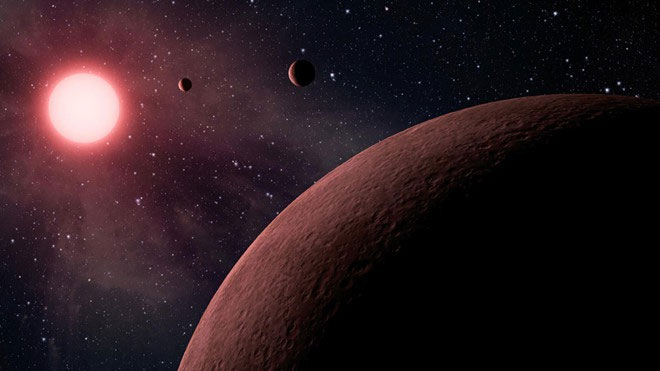Shocking theory: The mysterious 9th planet in the Solar System could be a black hole
The existence of planet 9 has been the subject of much debate in the scientific community for many years.
Astronomers have long hypothesized that the 9th planet with great gravity is thought to exist on the outer edge of the Solar System, which is responsible for the strange constriction of Kuiper Belt objects (including those that are outside the orbit of Neptune), as well as causing these objects to move irregularly in orbit around the Sun.
Although scientists have not directly observed the image of this mysterious object, there has been a lot of evidence to prove the existence of the 9th planet.

Scientists have long suspected the existence of a mysterious object on the edge of the Solar System, which has enormous gravitational forces acting on Kuiper Belt objects.
In 2015, researchers at the California Institute of Technology found mathematical evidence of "Planet X", also known as Planet Ninth . Based on a mathematical model performed by supercomputers, this mysterious planet is thought to be 5 times heavier than Earth, located very far from the Sun at a distance of about 400 AU (1 AU equals the distance from Earth to Sun).
Meanwhile, the US space agency (NASA) in 2017 also confirmed the existence of a strange object located on the edge of the Solar System. Researchers at NASA think that this mysterious object is 10 times the size of Earth, and it takes 20,000 Earth years for the "9th planet" to complete a revolution around the Sun.
The 9th planet in the Solar System could be a miniature black hole
Most recently, a team of astronomers at the University of Illinois, Chicago (USA) has come up with a much more "shocking" hypothesis: The strange celestial object we observe may not. Must be a planet. Instead, this is actually a miniature black hole!
Dubbed by astronomers at the University of Illinois as "an interesting possibility , " this theory suggests that the very presence of a primitive black hole at the edge of the Solar System caused some celestial phenomena. In the Kuiper belt, the orbits move abnormally.
According to the scientists' definition, the original black hole was the type of black hole formed in the earliest period of the universe, shortly after the Big Bang explosion. When the early universe was very dense with matter, the original black holes could not have formed from the collapse of stars. Instead, these black holes appear to be much smaller in size than the black holes we are currently studying.
Specifically, a primitive black hole 5 times heavier than the Earth can fit in the palm of our hands, while a black hole 10 times heavier than the Earth is the size of a bowling ball. This also means that the original black holes of microscopic size may be silently existing in the Solar System but have not been discovered by humans.

The Kuiper Belt is an object of the Solar System that extends from the orbit of Neptune to a distance of 44 AU from the Sun.
In order to prove that the hypothesis is correct, astronomers must naturally look for evidence that a primitive black hole really exists in the solar system. However, because the nature of black holes is to absorb all kinds of matter, including light as they cross the event horizon, finding black holes with telescopes in the usual way is extremely difficult. scarf with astronomers. Instead, a team at the University of Illinois has proposed finding the dark matter that exists in the halo around the black hole.
Specifically, a black hole the mass of a planet will have a halo of dark matter surrounding it, which can extend up to 1 billion km from the center of the black hole. Although dark matter cannot be directly detected, scientists can search for the existence of gamma beams generated by the interaction of dark matter molecules in the halo surrounding the hole. black. It is these gamma beams that will be the clue to finding the presence of black holes.

Gamma beams will be the clue to finding the presence of a black hole.
Currently, astronomers at the University of Illinois are aiming to find evidence to support their explanation by studying the data obtained from the Gamma Fermi Ray Telescope.
- The 9th planet: 1 year as long as 20,000 years Earth?
- Does the solar system have the 9th planet to own oceans and life?
- Is there a 'black hole solar system' that owns ... 10,000 planets?
- NASA first admitted to having a strange planet hidden in the Solar System
- Video: Compare the size of black holes in the universe
- Does the solar system have the 9th planet to own oceans and life?
- Event horizon - the boundary of the black hole
- Is the giant hole in the Sun really scary?
- Detecting a black hole
- The 9th planet of the solar system is ... stolen goods?
- New findings help prove the theory of black holes
- 99.99% has the 9th planet in the solar system
- The supermassive black hole is about to swallow 3 clouds of Earth
- Found a way to spot the 9th planet in the Solar System?
 Van Allen's belt and evidence that the Apollo 11 mission to the Moon was myth
Van Allen's belt and evidence that the Apollo 11 mission to the Moon was myth The levels of civilization in the universe (Kardashev scale)
The levels of civilization in the universe (Kardashev scale) Today Mars, the sun and the Earth are aligned
Today Mars, the sun and the Earth are aligned The Amazon owner announced a secret plan to build a space base for thousands of people
The Amazon owner announced a secret plan to build a space base for thousands of people